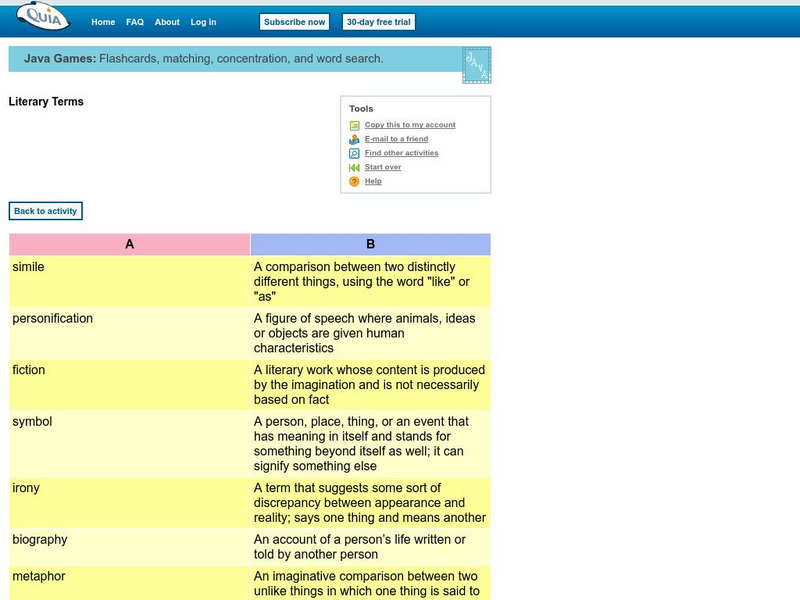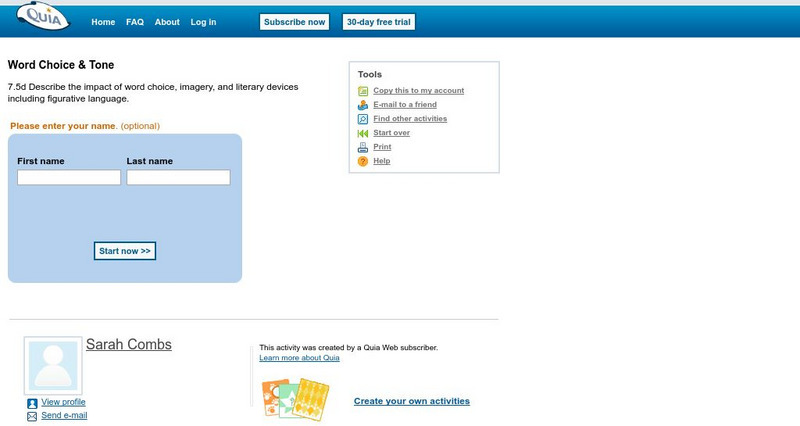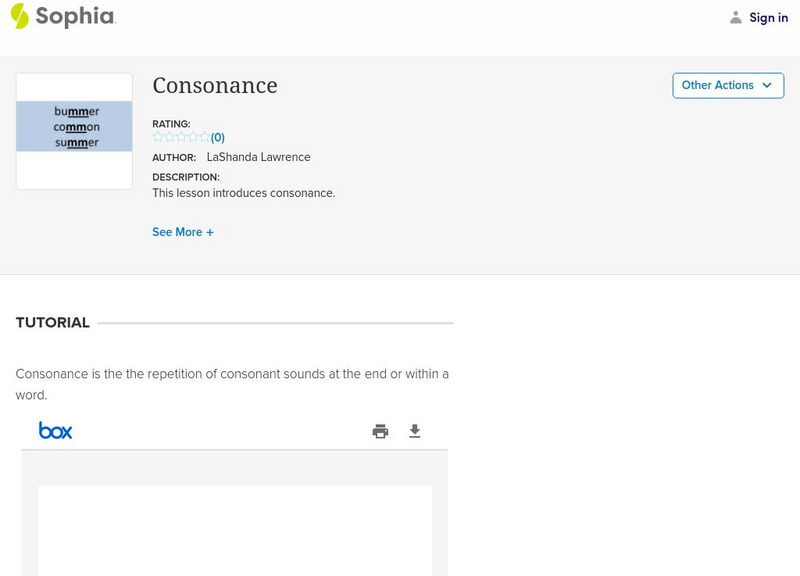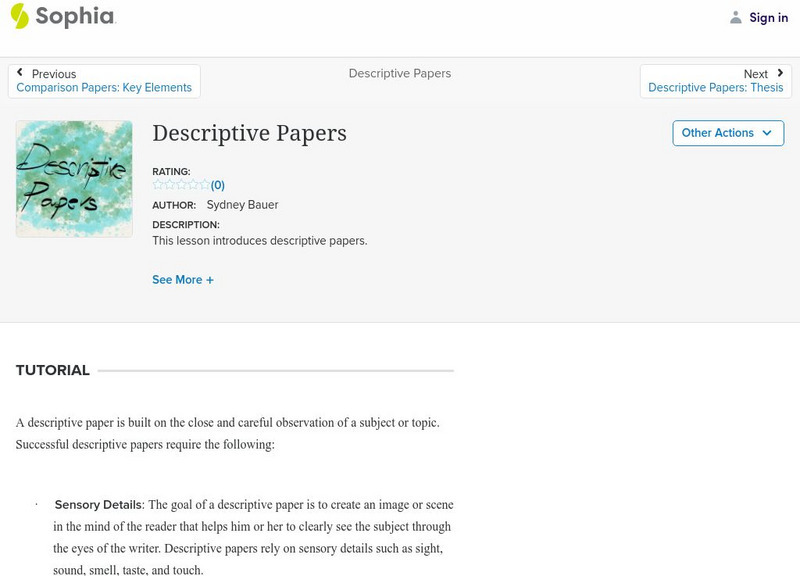Alabama Learning Exchange
Alex: What Are Idioms?
After listening to More Parts by Tedd Arnold read aloud, intermediate school students distinguish between literal and figurative meaning by using a graphic organizer, playing an online game, and incorporating an idiom into their writing.
PBS
Pbs Learning Media: Literary Elements and Techniques: Figurative Language
Discover how authors use figurative language to enhance their writing and explore the differences between similes and metaphors in this animated video [3:37] from WNET. Discussion questions below help students to further apply their...
Khan Academy
Khan Academy: The Sound of Language
Can you spot writers' use of alliteration, assonance, and onomatopoeia that add sound effects to their language?
South Carolina Educational Television
Know It All: Using Figurative Language to Shape Meaning and Style
The students will be able to identify different types of figurative language in a story and explain how the author uses figurative language to shape the meaning and style of the story.
Louisiana Department of Education
Louisiana Doe: Louisiana Believes: English Language Arts: Grade 9: Romeo and Juliet
Students explore how patterns and contrasts in language (diction, imagery, figurative language) reveal central ideas in texts and develop various motifs (light vs. dark, dreams vs. reality, high vs. low, etc.) in Romeo and Juliet. They...
Ted Nellen
Cyber English (By Ted Nellen): Literary Term: Onomatopoeia
For a clear explanation of onomoatopoeia and several examples from well-known poets, use this page.
Scholastic
Scholastic: Exploring Author's Language in "The River" [Pdf]
Students will learn about literary devices as used in Gary Paulsen's "The River." This guide also supplies suggestions for group activities (PDF, requires Adobe Reader.)
Ted Nellen
Cyber English (By Ted Nellen): Literary Terms F R
The second of three pages of simple definitions for literary terms. This page, F - R, covers forty-seven terms from "Fable," to "Romance."
Quizlet
Quizlet: Flashcards: Figurative Language Level 1
Practice learning figurative language using these audio-enabled flashcards with literary terms and their definitions. Also provided is a list of terms and definitions (audio available) and links to games and a test. Java is required....
Ted Nellen
Cyber English (By Ted Nellen): Hyperbaton
This is a glossary entry for the figure of speech "Hyperbaton" including definitions from two sources.
abcteach
Abcteach: Onomatopoeia Form
Printable form to reinforce student's understanding of onomatopoeia.
Chase Young, PhD
Dr. Chase Young, Ph D: Reader's Theater Script: The Poem "Simile" [Pdf]
A reader's theater script for "Simile", a poem, is provided on this script. Eleven character roles are needed in this performance.
Quia
Quia: List of Literary Terms
A list of 28 literary terms with brief, clear definitions. "Nonfiction," is the last term in the list.
Quia
Quia: Rags to Riches: Idioms From Context
In this interactive, "millionaire-style" game, students read passages with idioms in them. Then they will select the correct explanation for each idiom.
Other
Class Tools: Choose Game Formats: Figurative Language
Pick a game format that you would like to play: "Matching Pairs", "Wordshoot", "Flashcards", "Manic Miner", or "CannonBall Fun". For each game, choose the literal meaning for the figurative language presented. Also available in formats...
Quia
Quia: Word Choice and Tone Quiz
This interactive series of questions assesses students' understanding of the impact of word choice on the tone of a passage. Students will identify the correct tone used in sentences, paragraphs, and poems.
Sophia Learning
Sophia: Descriptive Papers: Key Elements: Lesson 2
This lesson goes over words, phrases, and key elements that are included in descriptive papers. It is 2 of 2 in the series titled "Descriptive Papers: Key Elements."
Sophia Learning
Sophia: Similes: Lesson 2
This slideshow lesson defines similes, discusses their purpose in writing, and provides examples.
TES Global
Blendspace: Figurative Language
A forty-six part learning module including links to informational texts, videos, pictures, practice exercises and more on various types of figurative language such as simile, metaphor, personification, idiom, alliteration, hyperbole, and...
TES Global
Blendspace: Similes and Metaphors
An eighteen-part learning module with links to videos, charts, and images to teach similes and metaphors.
TES Global
Blendspace: La Figurative Language: Alliteration
A six-part learning module with images, charts, and videos filled with explanations and examples of alliteration.






![Scholastic: Exploring Author's Language in "The River" [Pdf] Website Scholastic: Exploring Author's Language in "The River" [Pdf] Website](https://content.lessonplanet.com/knovation/original/34487-fb6f673c15b1f6a9b904e42e1affec9f.jpg?1661409227)














